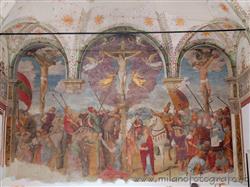|
Cloisters of the Umanitaria
|
|
|
Show an other treasure of art and history in Milan:
|
 Mostly represented styles: Renaissance Mostly represented styles: Renaissance
The history of the Cloisters of the Umanitaria begins in the fifteenth century, during the rule of the Sforza, and is linked to the history of Amedeo Mendes da Silva, noble of Iberian origins who became a Franciscan once he came to Milan. The community which he founded in Milan was a few years later made the subject by the Duchess Bianca Maria Visconti and her son Galeazzo Maria of an important donation and an allocation of a large area, at that time in the perifery of the city, where to settle permanently.
In the third quarter of the fifteenth century the construction of the church and of the convent started. The church was consecrated in 1497.
The convent, which at the end of the sixteenth century possessed 60 cells and 3 cloisters, already a century later had been enlarged with 30 more cells and a further cloister.
The refectory of the convent, now the precious hall of the frescoes (pictures 2-4 and large picture), was richly adorned with a Crucifixion by Bernardino Ferrari (1520), a Last Supper by Lomazzo (copy of the Last Supper by Leonardo da Vinci) and works of Marco d'Oggiono. Of the various works, unfortunately, only the first is still present to this day. The second went destroyed during the Second World War.
In 1805 the complex was requisitioned by Napoleon, deconsecrated and aquired by the state; later it shared the fate of other religious buildings in northern Italy, becoming a stable, then a warehouse, a hospital and finally a reform school.
Between the nineteenth and the twentieth the fate of the church and of the convent divided. The church was used as a concert hall, but later the property passed to the Sisters of St. Mary of Reparation, who returned it to worship and to its original function in 1907.
It was then acquired in 1967 by the Knights of the Holy Sepulchre of Jerusalem, who still manage the property.
The convent, however, passed from the hands of the Reformatory Marchiondi to the properties of Prospero Mosè Loria, Italian entrepreneur and philanthropist belonging to a Jewish family of Mantua, who made it to the headquarter of the Società Umanitaria, ("Humane Society"), which he created with the objective to "put the dispossessed, without distinction, in a position to be improve their condition by themselves, providing them with support, work and education."
The Società Umanitaria still exists today (despite difficult times, especially during fascism) and the spaces of its historic headquarters are therefore currently used for courses, workshops, performances and other events.
In one of the cloisters there is also a bar/restaurant.
Pictures taken during the guided tour at the cloisters of the Umanitaria
If you are interested in a guided tour of this monument send an email!
Categories: Others
Via San Barnaba, 48 20122 Milano |
Further pictures of the Cloisters of the Umanitaria in the section Photography |